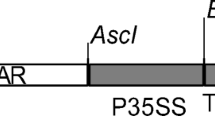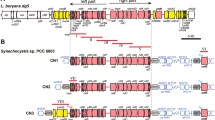Abstract
Genetic engineering in filamentous N2-fixing cyanobacteria usually involves Anabaena sp. PCC 7120 and several other non-aggregating species. Mass culture and harvest of such species are more energy consuming relative to aggregating species. To establish a gene transfer system for aggregating species, we tested many species of Anabaena and Nostoc, and identified Nostoc muscorum FACHB244 as a species that can be genetically manipulated using the conjugative gene transfer system. To promote biodegradation of organophosphorus pollutants in aquatic environments, we introduced a plasmid containing the organophosphorus-degradation gene (opd) into Anabaena sp. PCC 7120 and Nostoc muscorum FACHB244 by conjugation. The opd gene was driven by a strong promoter, P psbA . From both species, we obtained transgenic strains having organophosphorus-degradation activities. At 25°C, the whole-cell activities of the transgenic Anabaena and Nostoc strains were 0.163±0.001 and 0.289±0.042 unit/μg Chl a, respectively. However, most colonies resulting from the gene transfer showed no activity. PCR and DNA sequencing revealed deletions or rearrangements in the plasmid in some of the colonies. Expression of the green fluorescent protein gene from the same promoter in Anabaena sp. PCC 7120 showed similar results. These results suggest that there is the potential to promote the degradation of organophosphorus pollutants with transgenic cyanobacteria and that selection of high-expression transgenic colonies is important for genetic engineering of Anabaena and Nostoc species. For the first time, we established a gene transfer and expression system in an aggregating filamentous N2-fixing cyanobacterium. The genetic manipulation system of Nostoc muscorum FACHB244 could be utilized in the elimination of pollutants and large-scale production of valuable proteins or metabolites.
Similar content being viewed by others
References
Chungjatupornchai W, Fa-Aroonsawat S. 2008. Biodegradation of organophosphate pesticide using recombinant cyanobacteria with surface-and intracellular-expressed organophosphorus hydrolase. J. Microbiol. Biotechnol., 18: 946–951.
Elhai J. 1993. Strong and regulated promoters in the cyanobacterium Anabaena PCC 7120. FEMS Microbiol. Lett., 114: 179–184.
Elhai J, Vepritskiy A, Muro-Pastor A M, Flores E, Wolk C P. 1997. Reduction of conjugal transfer efficiency by three restriction activities of Anabaena sp. Strain PCC 7120. J. Bacteriol., 179: 1 998–2 005.
Elhai J, Wolk C P. 1988. Conjugal transfer of DNA to cyanobacteria. Methods Enzymol. 167: 747–754.
Harper L L, McDaniel C S, Miller C E, Wild J R. 1988. Dissimilar plasmids isolated from Pseudomonas diminuta MG and a Flavobacterium sp. (ATCC27551) contain identical opd genes. Appl. Environ. Microbiol., 54: 2 586–2 589.
Kuritz T, Wolk C P. 1995. Use of filamentous cyanobacteria for biodegradation of organic pollutants. Appl. Environ. Microbiol., 61: 234–238.
Lichtenthaler H K. 1987. Chlorophylls and carotenoids, the pigments of photosynthetic biomembranes. Methods Enzymol., 148: 350–382.
Manasherob R, Otieno-Ayayo ZN, Ben-Dov E, Miaskovsky R, Boussiba S, Zaritsky A. 2003. Enduring toxicity of transgenic Anabaena PCC 7120 expressing mosquito larvicidal genes from Bacillus thuringiensis ssp. israelensis. Environ. Microbiol. 5: 997–1 001.
McDaniel C S, Harper L L, Wild J R. 1988. Cloning and sequencing of a plasmid-borne gene (opd) encoding a phosphotriesterase. J. Bacteriol., 170: 2 306–2 311.
Mulbry W W, Karns J S. 1989. Parathion hydrolase specified by the Flavobacterium opd gene: relationship between gene and protein. J. Bacteriol., 171: 6 740–6 746.
Mulbry W W, Karns J S, Kearney P C, Nelson J O, Mcdaniel C S, Wild J R. 1986. Identification of a plasmid-borne parathion hydrolase gene from Flavobacterium sp. by southern hybridization with opd from Pseudomonas diminuta. Appl. Environ. Microbiol., 51: 926–930.
Munnecke D M. 1976. Enzymatic hydrolysis of organophosphate insecticides, a possible disposal method. Appl. Environ. Microbiol., 32: 7–13.
Shen Y, Li S. 1993. Cultivation and application of the nitrogen-fixing blue-green algae: results and prospects. Acta. Hydrobiol. Sin., 17: 357–364.
Shao Q, Shi D, Hao F, Ma L, Chen Z, Yu M, Ru B. 2002. Cloning and expression of metallothionein mutant α-KKS-α in Anabaena sp. PCC 7120. Mar. Pollut. Bull. 45: 163–167.
Stanier R Y, Kunisawa R, Mandel M, Cohen-Bazire G. 1971. Purification and properties of unicellular blue-green algae (order chroococcales). Bacteriol. Rev. 35: 171–205.
Wu X, Vennison S J, Liu H, Ben-Dov E, Zaritsky A, Boussiba S. 1997. Mosquito larvicidal activity of transgenic Anabaena strain PCC 7120 expressing combinations of genes from Bacillus thuringiensis subsp. israelensis. Appl. Environ. Microbiol., 63: 4 971–4 975.
Xu X, Kong R, Hu Y. 1993. High Larvicidal activity of intact recombinant cyanobacterium Anabaena sp. PCC 7120 expressing Gene 51 and Gene 42 of Bacillus sphaericus 2297. FEMS Microbiol. Lett., 107: 247–250.
Xu X, Wolk C P. 2001. Role for hetC in the transition to a nondividing state during heterocyst differentiation in Anabaena sp. J. Bacteriol., 183: 393–396.
Author information
Authors and Affiliations
Corresponding author
Additional information
Supported by the National High Technology Research and Development Program of China (863 Program) (No. 2002AA601170) and the National Natural Science Foundation of China (No. 30623001)
Rights and permissions
About this article
Cite this article
Li, Q., Tang, Q., Xu, X. et al. Expression of organophosphorus-degradation gene (opd) in aggregating and non-aggregating filamentous nitrogen-fixing cyanobacteria. Chin. J. Ocean. Limnol. 28, 1248–1253 (2010). https://doi.org/10.1007/s00343-010-9999-9
Received:
Accepted:
Published:
Issue Date:
DOI: https://doi.org/10.1007/s00343-010-9999-9




